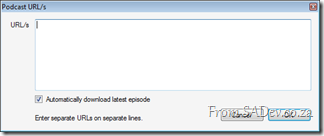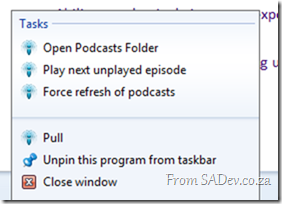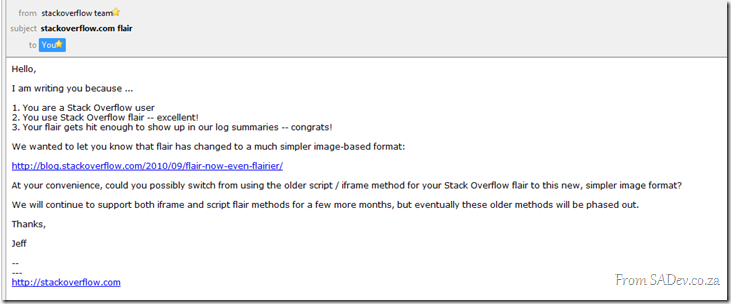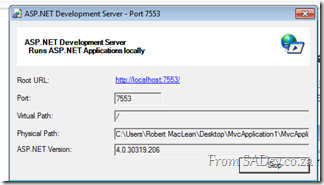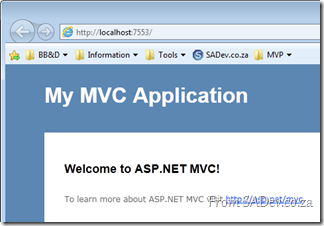Tech·Ed Africa 2010 - Slides, scripts and demos for my talks
Tech·Ed Africa 2010 ended on Wednesday and it was a great event. Thanks to everyone who came to my sessions and came up to me after and between sessions to chat. I felt very honoured to be able to meet and share with you :D
This post is for those who want the slides or demo information. I have completed versions of the demos below (in the zip file) and the script for each demo which gives you the step by step process I used (in the docx file).
APS302 – Intro to Workflow Services and Windows Server AppFabric
Other content for this session:
APS309 – Windows Server AppFabric Caching What it is and When you should use it
Other content for this session:
APS310 – WCF Made Easy with .NET 4 and Windows Server AppFabric
Other content for this session:
Pull - October 2010 Release
I’m happy to share my second stable release of Pull, the simplest podcast/vidcast download tool, in the world, this release has had a ton of new work done to it to get it more usable and some plumbing work to improve it.
Major features in this release
Full Proxy Support
Proxies are either really easy to use or completely destroy your application. Previously Pull used what ever Internet Explorer specified, now you can tell it there is no proxy, in case your IE proxy settings are different for some reason, or provide proxy settings. This should help people use it in a variety of environments.
Add multiple podcasts at once
Want to subscribe to multiple podcasts? Just use the new add dialog box to add them.
Automatic backup of feeds to OPML
Have a database? Then you better have a backup. These are rules for all software and Pull does the same now by automatically backing up your feeds to an OPML file, just in case ![]()
New jumplist options
Right click on the Pull icon in Windows 7 and you will get the jumplist which contains two new options – Play next unplayed episode and Force refresh of podcasts.
Since putting in the play un-played I’ve used it a ton as it allows me to keep playing podcasts quickly. When one podcast finishes, it is two clicks to get the next one started, without having to switch to the application to do it!
Ability to automatically download latest episode when subscribing to a podcast
When you subscribe to a podcast, you likely want the latest episode and so we now have an options to enable that. Options are available on both the new podcast dialog box (see above) and also if you are adding via protocol handlers or OPML.
For those last two you can turn it off in the settings:
Ability to cancel downloads
Right click on a download in the download pane and you will be able to cancel a download!
Locking
Often I have a podcast I want to keep forever, now you can right click on a podcast and select lock which adds a little lock icon next to it. Repeat the process to unlock.
This prevents the file from being deleted and from a clean-up perspective this means you can now select all played episodes and hit delete and it will ignore the locked items.
Ability to prevent Windows from going to sleep during downloads
In settings you can control if you have an active download is the computer allowed to go to sleep.
Ability to selectively import or export podcasts from OPML file
Want to export your podcast, except that one which will make your mother blush? Or maybe your friend gave you an OPML file you want to import but you don’t want all his podcasts. You can now select individual podcasts and export and import selectively.
Delete to recycle bin
When you delete a podcast, it now goes to the recycle bin and not into the ether. This also means you can hit retry now if the delete fails for any reason.
Scan for Episodes
Another new small feature lets you scan an existing folder for episodes you have already downloaded in Pull or other application. This was added to help people migrate to Pull and quickly associate their existing episodes, but if you want to re-associate a deleted episode this works great for that too!
Welcome wizard to make getting up and running easy
Pull used to only need two settings from you and so when you started it for the first time it showed you the settings dialog to get those settings. However this release added a number of settings and to not scare off a new user with a million settings we get now start with a simple welcome wizard which asks for the two we really need and makes the user feel at home in the application.
Future
I am planning another release for about a month away and I want to add some more download management features in it but if you have any ideas drop me a line or leave a message in the Pull discussions forum.
Win a copy of Visual Studio Ultimate!!
 Fellow ALM MVP, Zayd Kara, and myself have obtained FOUR Visual Studio 2010 Ultimate licenses to giveaway at the Tech·Ed 2010 Africa Community Lounge! Each license is valued at over $11,000 and includes a MSDN subscription*!
Fellow ALM MVP, Zayd Kara, and myself have obtained FOUR Visual Studio 2010 Ultimate licenses to giveaway at the Tech·Ed 2010 Africa Community Lounge! Each license is valued at over $11,000 and includes a MSDN subscription*!
If you want the best development software then you better be at the community lounge next week!
And if you not a programmer, then still come to the Community Lounge to win a Xbox 360 or Flying Screaming Monkeys sponsored by BB&D! Or one of many cool giveaways, like rugby stress balls, from the Information Worker community!
* Terms and Conditions apply
When the Tech·Ed craving has you?

 BB&D is once again sponsoring the community lounge at Microsoft Tech·Ed Africa 2010! This year there is some fantastic prizes to be won in the community lounge thanks to BB&D.
BB&D is once again sponsoring the community lounge at Microsoft Tech·Ed Africa 2010! This year there is some fantastic prizes to be won in the community lounge thanks to BB&D.
The big prize is a Microsoft Xbox 360, but there is also some smaller prizes available. The one I am most excited about is the Flying Screaming Monkey who looks a like a cross between Zoro and the monkey from the Chicken Licken adverts.
What makes him really cool is his arms are springs, so you can stretch him like a slingshot and when you let him go he flies across the open plan office inflicting monkey love on any unsuspecting co-worker.
To even the odds though, he screams the entire flight (and if he screams again if he hits the ground hard enough), so your co-workers do have some time to duck out of the monkeys flight path!
If you are keen to win a monkey of your own, a Xbox or any other prize head over to the community lounge at Tech·Ed!
StackExchange Flair
For a while the flair on my site has included my stats from StackOverflow, ServerFault and SuperUser. In my article on it, I mentioned I used the iFrame but I stopped that a few months ago and switched to getting the JSON data for my accounts directly and parsing that. I did this as it was order of magnitudes faster than loading via the iFrame.
For those who attended my DevDays talks, they would recognise that code as it is the same as I used in my demos.
Then recently an email arrived:
Damn, my jQuery magic was about to end so what could I do but change? When I started looking at the new flair I noted that StackOverflow wanted me to hotlink the image, i.e. have my visitors get it from their server, but the performance for pulling the image was still poor compared to my own website (or so the Firebug tool says). So what could I do to improve this?
What I did was to use wget, which is a Linux tool (I’m hosted on a Linux box) for downloading files, and put that in a schedule to once a day download my StackExchange flair and store it on my website, which means it gets served faster. As my numbers won’t change heavily day to day, (I’m not Skeet) once a day is enough balance between keeping it fresh and making it cachable.
The only downside is that my flair uage stats on StackExchange will likely drop, but I don’t really care about that.
The wget command is:
wget http://stackexchange.com/users/flair/1c5ab06b9a844e49b817e7eeb31977e0.png –O <path>/files/stackexchange.png
Poken @ Tech·Ed 2010
![image[8] image[8]](https://www.sadev.co.za/files/image8_thumb.png) We live in an increasing digital and disconnected world where we seldom meet face to face, and in less than a week that will all change because it will be time for Tech·Ed Africa 2010! Last year there was a new piece of hardware unveiled, the Poken – which I can assure you will be even bigger this year.
We live in an increasing digital and disconnected world where we seldom meet face to face, and in less than a week that will all change because it will be time for Tech·Ed Africa 2010! Last year there was a new piece of hardware unveiled, the Poken – which I can assure you will be even bigger this year.
For those who do not know what a Poken is, it’s a small device which links your digital persona to a physical world! Or put more simply it’s a way to share details about who you are with other people, think like a digital business card.
From Ruari Plints post on these guys, here is what you need to do:
- Pop onto Poken website to find out all about it and why we going crazy “Poken-ing” everyone this year.
- Sign up foryou own Poken account.
- Get your Poken device, before or at TechEd Africa.
- Join us and go “Poken” you friends, and then some.
- Create your own “Poken” language and make us all laugh at the possibilities.
- Pop on to the TechEd Social media sites and start expressing yourself.
I have it on good authority that the Poken’s on sale at the event will be at a special price and plenty will be available to WIN!
SharePint @ Tech·Ed 2010!
After a full day of learning new and interesting SharePoint tips, tricks and ideas, come and hang out with fellow SharePoint enthusiasts to help digest your new knowledge and a pint or two of anything else you like.
Hosted by The MOSS Show, with with some prizes to give away, it should be a fun evening for all.
RSVP essential as we need to finalise venue bookings!
Date: Monday, 18 Oct.
Venue: Cubana Durban, 128 Florida Road
Time: 7:00 p.m.
Dress: Collared shirts & smart shoes for gents
Map & Directions from the CCI: View Map
Click to Register Here
A special thanks to our Sponsors:
Tech·Ed Africa 2010 Twitter List
Looking for Tech·Ed Africa 2010 speakers and key accounts, like Xbox South Africa, on Twitter? The solution a Twitter list I create where you can find everyone in one place to follow individually or you can just follow the whole list.
List: @rmaclean/teched-africa
Being a list it is not filtered on hash tags and so on, which means you will likely get off topic discussion too.
If I am missing anyone, please let me know via the site or Twitter.
Tech·Ed Africa 2010 Calendar is AWESOME!
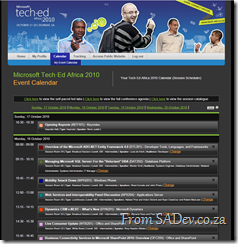 If you have registered for Tech·Ed Africa 2010, there is a feature that you just have to use – the calendar. I know calendars sound boring but this one is not! To use it login to your Tech·Ed Africa 2010 account (My Tech·Ed –> Login)
If you have registered for Tech·Ed Africa 2010, there is a feature that you just have to use – the calendar. I know calendars sound boring but this one is not! To use it login to your Tech·Ed Africa 2010 account (My Tech·Ed –> Login)  then click on Calendar –> My Event Calendar and you can click on each time slot and scroll through a list of content available at that timeslot.
then click on Calendar –> My Event Calendar and you can click on each time slot and scroll through a list of content available at that timeslot.
This has the benefit of helping focus you down to what is available and getting that planning out of the way but you may miss the BEST features it it. Once you have completed your planning you can use the small iCal and printer buttons at the top: ![]()
Print does exactly what you think – a clean print view: 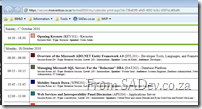
But the iCal is FANTASTIC – it provides you a file to bring into Outlook which lists all your sessions in your calendar so you can easily sync to your device – but more than that ALL the details is listed in the body of the invites so when you arrive at the event you can quickly recall what the session is about!
Internet Explorer 9 breaks with localhost
There is a known bug for this 601047This is resolved with RTM!
You can hear Eric Lawrence talk about this bug in the Herding Code Podcast
Internet Explorer 9 works great, except when it doesn’t, and it seems to not work for developers more than most, or maybe it’s just me (could the IE9 team be targeting me?).
Paranoia aside, there is an issue where when testing web applications (ASP.NET, MVC) or Silverlight applications from Visual Studio (i.e. press F5) it just refuses to load. Thankfully this has been confirmed by other people ![]()
What is going on and how do we solve this? Because it is really frustrating and it also makes for bad demos (especially with TechEd around the corner).
The first part of the problem is the ASP.NET Development Server which is what is hosting your websites when you hit F5.
Next part of the problem is Windows, especially since it assumes IPv6 is better than IPv4. Note in the picture below that when you ping localhost you get an IPv6 address.
So what appears to be happening is when IE9 tries to go to localhost it uses IPv6, and the ASP.NET Development Server is IPv4 only and so nothing loads and we get the error.
To solve this fire up notepad in administrator mode and navigate to <windows directory>\system32\drivers\etc\ and open the hosts file. Inside you will find a number of lines prefixed with a hash (which makes those lines comments). Remove the hash from the line which has 127.0.0.1 in it, as below and save.
This will cause Windows to resolve localhost to IPv4 first (you can confirm by pinging localhost) which means that IE9 will do the same and now it just works every time.


